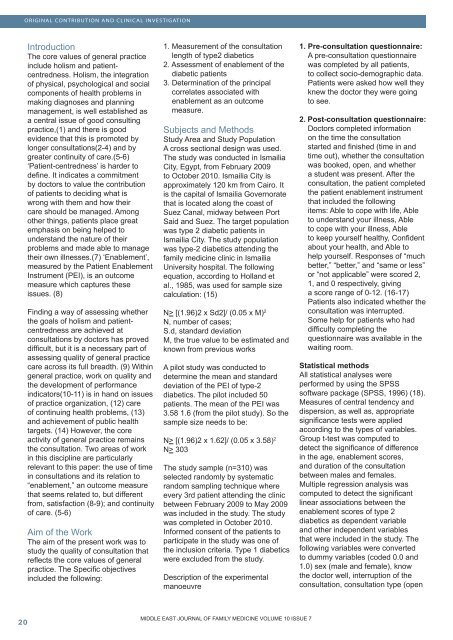full pdf of issue - Middle East Journal of Family Medicine
full pdf of issue - Middle East Journal of Family Medicine
full pdf of issue - Middle East Journal of Family Medicine
- No tags were found...
You also want an ePaper? Increase the reach of your titles
YUMPU automatically turns print PDFs into web optimized ePapers that Google loves.
ORIGINAL CONTRIBUTION AND CLINICAL INVESTIGATIONIntroductionThe core values <strong>of</strong> general practiceinclude holism and patientcentredness.Holism, the integration<strong>of</strong> physical, psychological and socialcomponents <strong>of</strong> health problems inmaking diagnoses and planningmanagement, is well established asa central <strong>issue</strong> <strong>of</strong> good consultingpractice,(1) and there is goodevidence that this is promoted bylonger consultations(2-4) and bygreater continuity <strong>of</strong> care.(5-6)‘Patient-centredness’ is harder todefine. It indicates a commitmentby doctors to value the contribution<strong>of</strong> patients to deciding what iswrong with them and how theircare should be managed. Amongother things, patients place greatemphasis on being helped tounderstand the nature <strong>of</strong> theirproblems and made able to managetheir own illnesses.(7) ‘Enablement’,measured by the Patient EnablementInstrument (PEI), is an outcomemeasure which captures these<strong>issue</strong>s. (8)Finding a way <strong>of</strong> assessing whetherthe goals <strong>of</strong> holism and patientcentrednessare achieved atconsultations by doctors has proveddifficult, but it is a necessary part <strong>of</strong>assessing quality <strong>of</strong> general practicecare across its <strong>full</strong> breadth. (9) Withingeneral practice, work on quality andthe development <strong>of</strong> performanceindicators(10-11) is in hand on <strong>issue</strong>s<strong>of</strong> practice organization, (12) care<strong>of</strong> continuing health problems, (13)and achievement <strong>of</strong> public healthtargets. (14) However, the coreactivity <strong>of</strong> general practice remainsthe consultation. Two areas <strong>of</strong> workin this discipline are particularlyrelevant to this paper: the use <strong>of</strong> timein consultations and its relation to“enablement,” an outcome measurethat seems related to, but differentfrom, satisfaction (8-9); and continuity<strong>of</strong> care. (5-6)Aim <strong>of</strong> the WorkThe aim <strong>of</strong> the present work was tostudy the quality <strong>of</strong> consultation thatreflects the core values <strong>of</strong> generalpractice. The Specific objectivesincluded the following:1. Measurement <strong>of</strong> the consultationlength <strong>of</strong> type2 diabetics2. Assessment <strong>of</strong> enablement <strong>of</strong> thediabetic patients3. Determination <strong>of</strong> the principalcorrelates associated withenablement as an outcomemeasure.Subjects and MethodsStudy Area and Study PopulationA cross sectional design was used.The study was conducted in IsmailiaCity, Egypt, from February 2009to October 2010. Ismailia City isapproximately 120 km from Cairo. Itis the capital <strong>of</strong> Ismailia Governoratethat is located along the coast <strong>of</strong>Suez Canal, midway between PortSaid and Suez. The target populationwas type 2 diabetic patients inIsmailia City. The study populationwas type-2 diabetics attending thefamily medicine clinic in IsmailiaUniversity hospital. The followingequation, according to Holland etal., 1985, was used for sample sizecalculation: (15)N> [(1.96)2 x Sd2]/ (0.05 x M) 2N, number <strong>of</strong> cases;S.d, standard deviationM, the true value to be estimated andknown from previous worksA pilot study was conducted todetermine the mean and standarddeviation <strong>of</strong> the PEI <strong>of</strong> type-2diabetics. The pilot included 50patients. The mean <strong>of</strong> the PEI was3.58 1.6 (from the pilot study). So thesample size needs to be:N> [(1.96)2 x 1.62]/ (0.05 x 3.58) 2N> 303The study sample (n=310) wasselected randomly by systematicrandom sampling technique whereevery 3rd patient attending the clinicbetween February 2009 to May 2009was included in the study. The studywas completed in October 2010.Informed consent <strong>of</strong> the patients toparticipate in the study was one <strong>of</strong>the inclusion criteria. Type 1 diabeticswere excluded from the study.Description <strong>of</strong> the experimentalmanoeuvre1. Pre-consultation questionnaire:A pre-consultation questionnairewas completed by all patients,to collect socio-demographic data.Patients were asked how well theyknew the doctor they were goingto see.2. Post-consultation questionnaire:Doctors completed informationon the time the consultationstarted and finished (time in andtime out), whether the consultationwas booked, open, and whethera student was present. After theconsultation, the patient completedthe patient enablement instrumentthat included the followingitems: Able to cope with life, Ableto understand your illness, Ableto cope with your illness, Ableto keep yourself healthy, Confidentabout your health, and Able tohelp yourself. Responses <strong>of</strong> “muchbetter,” “better,” and “same or less”or “not applicable” were scored 2,1, and 0 respectively, givinga score range <strong>of</strong> 0-12. (16-17)Patients also indicated whether theconsultation was interrupted.Some help for patients who haddifficulty completing thequestionnaire was available in thewaiting room.Statistical methodsAll statistical analyses wereperformed by using the SPSSs<strong>of</strong>tware package (SPSS, 1996) (18).Measures <strong>of</strong> central tendency anddispersion, as well as, appropriatesignificance tests were appliedaccording to the types <strong>of</strong> variables.Group t-test was computed todetect the significance <strong>of</strong> differencein the age, enablement scores,and duration <strong>of</strong> the consultationbetween males and females.Multiple regression analysis wascomputed to detect the significantlinear associations between theenablement scores <strong>of</strong> type 2diabetics as dependent variableand other independent variablesthat were included in the study. Thefollowing variables were convertedto dummy variables (coded 0.0 and1.0) sex (male and female), knowthe doctor well, interruption <strong>of</strong> theconsultation, consultation type (open20 MIDDLE EAST JOURNAL OF FAMILY MEDICINE VOLUME 10 ISSUE 7MIDDLE EAST JOURNAL OF FAMILY MEDICINE • VOLUME 7, ISSUE 10
















